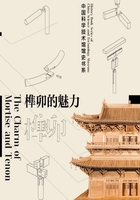
前言
榫卯是7000 年前古代中国人的一项重大发明。它是木构件上采用的凹凸连接方式。凸的部分叫榫,凹的部分叫卯,榫头插入卯眼中,两块木头就会紧紧地连为一体,使独立的、松散的构件结合成具有荷载能力的结构体。榫卯用途广泛,它不仅是中国古典建筑和家具的核心构成元素,还被应用于舟车、造桥等其他领域。中国古代工匠创造出种类繁多、精巧无比的各式榫卯。构件之间,不用一根金属钉,就可以做到间不容发、天衣无缝,体现了古人的设计匠心与造物智慧。除了精美、实用等优点外,榫卯结构还蕴含着中国古人的阴阳互补、虚实相生的哲学思想,凝结了中国几千年的传统文化精粹。
榫卯是古代科学技术与文化艺术的美妙结晶,承载着造物领域的民族记忆,凝聚了中国人追求完美、精益求精的工匠精神。但是随着科技的发展,木材之间的榫卯连接渐渐被五金构件、化学黏合剂所取代,公众对这项传统工艺的了解越来越少。为响应习近平主席提出的“ 践行文化自信,努力展示中华文化独特魅力”的号召,中国科学技术馆自主研发了“榫卯的魅力”主题展览。展览面积为2000 平方米,展品38 件(套),共设置5 个单元:七千年前的发明、古代建筑的智慧、中式家具的灵魂、形形色色的榫卯、现代榫卯的演变。展览以榫卯为中心,通过实物、微缩模型、互动模型、多媒体、木工工坊等丰富多彩的展览与教育形式,讲述榫卯的起源,展示榫卯工艺在古代建筑、中式家具、造船造桥等不同领域以及现代生产生活中的应用。旨在传播古代科技、传承文化遗产、弘扬工匠精神,引领观众感受榫卯经久不衰的魅力。
我们特将展览内容汇编成《榫卯的魅力》展览图文集,借此让更多的人走近榫卯,了解这一中国古老的传统工艺,感受其科学精巧的设计、深厚的文化底蕴与含蓄的内在美。
展览在筹备过程中得到了许多专家学者的指导与帮助,在此表示诚挚的感谢和敬意。展览参考和引用的图书与论文,因图书体例的缘故,未能在书中一一注明,我们也在此向文献作者表示感谢。
谨以此展览与图文集致敬中国历史上的能工巧匠们。
《榫卯的魅力》编委会
Preface
Mortise and tenon, a great invention 7,000 years ago by ancient Chinese people, is a concave-convex connection method used on wooden components. The concave part is called mortise, while the convex part is called tenon. When the tenon is inserted into the mortise, the two pieces of wood will be tightly connected, so that the independent and loose components can be combined into a building with large load capacity. Mortise and tenon is widely used. It is not only the core element of Chinese classical architecture and furniture, but also used in ships, vehicles, bridge building and other fields. Ancient Chinese craftsmen created a wide variety of exquisite mortise and tenon structures. Without a metal nail between the components, those mortise and tenon structures could fit tight and seamlessly, which reflects the ingenuity and wisdom of the ancient craftsmen. In addition to the advantages of delicacy and practicality, mortise and tenon structures also embody the ancient Chinese philosophy of yin-yang complementation and the transformation of the real and the virtual, epitomizing the essence of Chinese traditional culture of thousands of years.
Mortise and tenon is the wonderful crystallization of ancient science and technology, culture and art, bearing the national memory of the field of creation and embodying the craftsman spirit of Chinese people in pursuit of perfection and excellence. However, with the development of science and technology, the mortise and tenon connections between wooden componentsare gradually replaced by metal hardwa rec om ponen ts and chemical binders,and the public are losing knowledge of this traditional technology. In response to President Xi Jinping’s call for “practicing cultural confidence and demonstrating the unique charm of Chinese culture”, China Science and Technology Museum independently developed the theme exhibition“The Charm of Mortise and Tenon”. The exhibition area is 2,000 squaremeters, with about 38 pieces (sets) of exhibits. There are five sections: The Invention from 7,000 Years Ago, The Wisdom of Ancient Architecture, The Soul of Chinese Furniture, Various Kinds of Mortise and Tenon and The Evolution of Modern Mortise and Tenon. Focusing on mortise and tenon, the exhibition tells the origin of mortise and tenon through various forms of exhibits and education programs, such as physical objects, miniatures,interactive models, multimedia, carpentry workshops, etc., and shows the application of mortise and tenon technology in different fields such as ancient architecture, Chinese furniture, ship building and bridge building, as well as in modern production and life. The exhibition aims to spread ancient science and technology, inherit cultural heritage, carry forward the craftsman spirit and lead the audience to experience the enduring charm of mortise and tenon.
It is precisely in this spirit that we have compiled The Charm of Mortise and Tenon so as to let more people approach mortise and tenon, understand this ancient Chinese traditional technology, and feel its scientific and exquisite design, profound cultural heritage and implicit inherent beauty.
The exhibition has been guided and helped by many experts and scholars in the preparatory process. We would like to express our sincere thanks and respect. And because of the style of this book, the documents referenced and quoted in the exhibition cannot be specified in the book one by one. We sincerely salute the authors of the documents.
We hereby dedicate the exhibition and book to the great scientists and
skilled artisans in ancient China.
Board of Editors for
The Charm of Mortise and Tenon